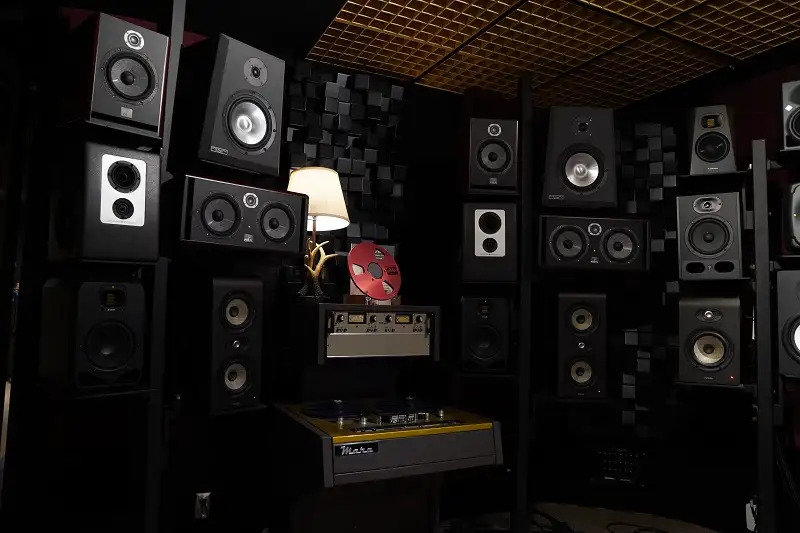
28 Feb The Realm of Effective Acoustics Part 5: Home Stereo Systems
Enter the realm of effective acoustics. Here we dispel common misconceptions and look at the proper ways to solve noise and sound problems, from making a room sound better to controlling and measuring noise.
Our journey is almost complete. Along the way we’ve looked at sound isolation, YouTube acoustics, noise-measuring smartphone apps, and event noise. It’s a diverse group of topics, yet this diversity is a reminder of the many ways noise can influence and affect our lives. Today’s topic takes us home, right to our living rooms. We are talking about home stereos, of course, and we’ll discuss how room acoustics can help your system sound its best.
Home Stereo Myths: Coming at You from All Sides
The home stereo market is relatively saturated. To stand out, stereo and component companies try to highlight the reasons why their products sound the best. As you might guess, claims of improved sound quality can range from reasonable to ridiculous.
While we here at BKL don’t consult on AV design, room acoustics—one of our specialties—plays a significant part in how people perceive the sound quality of their home stereos and theatre systems. Here are some audio-related room acoustics myths that you can throw in the trash, right along with those gold-plated cables.
Myth Number 1: Acoustical Treatment Is Only for Show
A good equalizer is all I need, right? Wrong. Many audio issues in home hi-fi have little to do with the system, but everything to do with the room.
Every room has a “sound” or response. The goal of acoustical treatment is to remove unevenness, that is, the dips and bumps in the room’s response. Your equalizer is for the last little tweaks. Still, it can reach a completely even response in only one spot within a room. But that’s not necessarily a bad thing. A completely even room can sometimes sound a bit flat. As in boring.
Myth Number 2: The Room Doesn’t Affect Quiet Music
If I play music at a low volume, the room doesn’t contribute to the experience, right? Wrong again. The room’s acoustic effects are triggered by even the quietest sounds.
Myth Number 3: Upgrading Components Always Improves the Sound
I can improve my sound with new gear, right? Beyond a certain point, no. If your cables are shielded properly, your loudspeakers aren’t physically broken, and your components (amp, player, etc.) are working normally, upgrading equipment will more often lead to differences than actual improvements. Maybe the right question is this: How do you quantify an improvement?
Most of the time, issues with “bad sound” in a room are due to either a lack of acoustical treatment or poor loudspeaker placement. Try moving the loudspeakers slightly away from the walls (especially corners) of your room. Or bring all your blankets and rugs to your listening room and spread them around. I guarantee you’ll notice a change. If you are truly curious, take your hi-fi system outside (on a sunny day) and recreate the layout of your listening room on your lawn. Without walls and a ceiling (and with a fairly absorptive ground), you can hear what “flat” sounds like. And it won’t cost you a thing—unless it rains.
Myth Number 4: Egg Cartons Make an Effective DIY Acoustical Treatment
To do its job, acoustical treatment needs to have sufficient mass and be thick and bouncy. (For accuracy’s sake, I use “bouncy” here as a catchall for “fuzzy,” “porous,” and “flow resistant.”) So, no. Egg cartons are not ideal for acoustical treatment.
Proper treatment absorbs sound and converts a part of the sound energy into the movement of the material (and ultimately, heat, but don’t worry, you can’t burn your house down by listening to music).
The direct ratio of the portion of sound “staying” in the material and the portion reflecting back actually forms a descriptive value between 0 (all sound reflects) and 1 (all sound absorbs into the material). This is known as the absorption coefficient, and it’s the reason effective panels require the combination of mass (or momentum), thickness (buries the sound in between the edge of the panel and the wall), and “bounciness” (to allow for the movement).
Traditional mineral wool panels are thick, bouncy and have sufficient mass. Felt and other materials can work too. As do heavy curtains. Not egg cartons, though.
The thickness of acoustical treatment determines how well it absorbs lower frequencies. That is, the thicker the treatment, the better it is at soaking up low-end sounds. If your listening room sounds too “boomy” or “bassy,” you might need to add thicker treatment. A couch can be effective, but most couches aren’t large enough to cover the area needed for an even sound at low frequencies.
Here is a good rule of thumb: The wavelength of the F key above the middle C of a piano (approximately 345 Hz) is about 1 metre; the F under the middle C (172.5 Hz) is double that, 2 metres; and the F under that (88 Hz) is about 4 metres. This is around the range where consumer-grade loudspeakers start to roll off.
With about a quarter of the wavelength between the surface of your acoustical treatment and the wall, your treatment should fully absorb that frequency and above. An eighth of the wavelength is still decent, and a sixteenth can still be effective. The lower the note, the longer the wave. It’s no coincidence that most professional studios allow for about a metre of extra space around their listening room walls for acoustical treatment (a quarter of 88 Hz is 4 metres). Imagine shrinking your living room by a metre on each side. It would probably sound amazing, but the WAF would be close to zero.
Good System + Good Room = Good Sound
You could spend all your time and money trying to improve your hi-fi system. But having the right equipment is only part of what makes a stereo sound good. The layout of your listening room and the character and placement of acoustical treatment make significant contributions to the quality of your home stereo experience.
Regardless of room size or sound level, well-designed acoustics can ensure a room sounds its best. If you want to learn more about room acoustics, get in touch with one of our experts. Or check out our case studies to see our design work for studios, theatres, performance spaces, and more.
Written by Joonas Niinivaara



Sorry, the comment form is closed at this time.